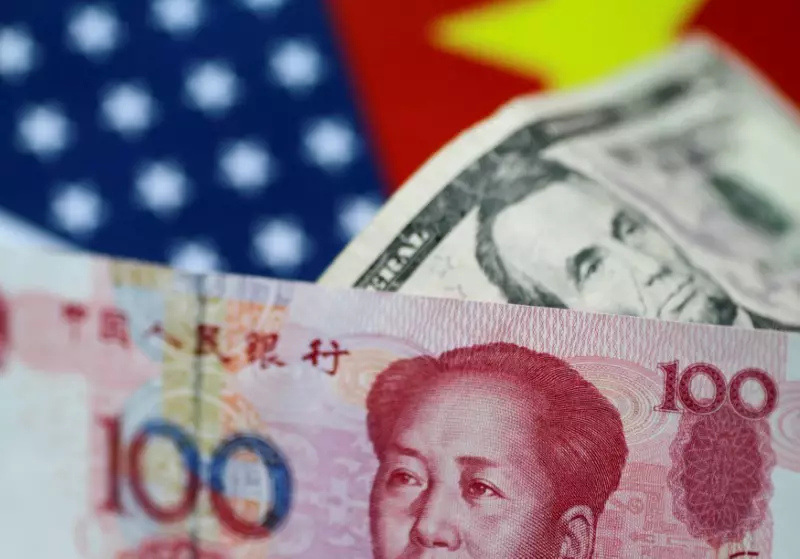In the realm of global finance, the dynamics of currency exchange often reveal underlying geopolitical tensions. Recently, the Chinese yuan has been under significant pressure, reaching a four-month low against a strengthening U.S. dollar. This shift can be traced back to heightened trade tensions stemming from U.S. President-elect Donald Trump’s alarming announcements regarding potential tariffs on BRICS nations, which include Brazil, Russia, India, China, and South Africa. These potential tariffs, which Trump insinuated might reach as high as 100%, raised immediate concerns regarding trade relations, causing ripples across Asian markets.
On a platform as ubiquitous as social media, Trump’s warning concerning tariffs aimed squarely at nations that might seek to undermine the dollar’s supremacy marked a volatile pivot in the financial landscape. His declarations not only threatened the stability of currencies in the BRICS nations but inferred a larger commentary on U.S. economic superiority. The rhetoric used by Trump reflects a more protectionist stance, echoing strategies from both his previous campaign and current political climate. Such moves are likely to reignite fears of a trade war that could reverberate around the globe.
As market participants adjust their strategies in response to this rhetoric, it is essential to recognize the dollar’s status as a safe-haven asset. With the U.S. Dollar Index seeing a marked increase—up by 0.5%—investors have gravitated toward the greenback, viewing it as a buffer against uncertainty created by Trump’s promises of economic repercussions for countries that might challenge U.S. financial hegemony.
Asian Currencies in a Downward Spiral
The implications of these developments have not been favorable for various Asian currencies. The South Korean won and Japanese yen were notably amongst the hardest hit, with the USD/JPY pair escalating by 0.6%. Similarly, the South Korean USD/KRW also surged 0.7%. Other currencies in the region, such as the Singapore dollar and Thai baht, slid by 0.5%. The difficulty that these currencies face can be linked to the broader expectation of U.S. monetary policy shifting in favor of a stronger dollar, further eroding confidence in Asia’s economic stability.
In particular, the Indian rupee faced its challenges too, reflecting an unsettling backdrop of economic data. Amid a backdrop where India’s GDP growth appeared to gradually slow, the rupee reached a concerning point against the dollar at 84.708. Although India remains among the fastest-growing major economies, its economic indicators paint a picture of fragility in the face of external pressures, particularly from U.S. trade policies.
Despite the yuan’s descent, there are signs of a fragile recovery within China’s economic framework. Statistics from November indicated a more favorable manufacturing sector, with both the official manufacturing PMI and the private-sector Caixin PMI reflecting growth. However, this recovery raises questions about sustainability amid ongoing trade disputes. The lackluster performance of Chinese exports against the backdrop of these rising tensions suggests that even positive indicators cannot entirely alleviate concerns regarding the Chinese economy’s resilience.
The yuan’s struggles—evident in its 1.8% depreciation against the dollar throughout November—highlight an intersection of domestic economic challenges and international stressors. With speculation regarding the Federal Reserve’s imminent monetary policy adjustments looming large, the prospect of a painstakingly slow rate cut further complicates the situation.
As key financial players await deliberations from central banks—such as the Reserve Bank of India’s forthcoming decision on interest rates—it is clear that the balancing act of fostering growth while mitigating risks associated with heightened geopolitical tensions will be critical. With the Federal Reserve’s anticipated December meeting signaling a quarter-point cut on the table, investors remain vigilant, looking for cues that will influence market directions.
This intricate web of geopolitical dynamics illustrates the volatility of currency markets, especially in regions heavily reliant on global trade. Traders and policymakers alike must navigate these uncertain waters with caution, prepared for fluctuations as the dialogue surrounding tariffs and economic strategies continues to evolve. Ultimately, the interconnectedness of global economies underscores that the ramifications of Trump’s proclamations on BRICS tariffs will be felt well beyond the immediate sphere of influence, serving as a stark reminder of the fragility of international relations in an economically intertwined world.


Leave a Reply